Apple 15-inch MacBook Pro (Late 2011) Review
by Anand Lal Shimpi on November 17, 2011 5:10 PM EST- Posted in
- Mac
- Apple
- Intel
- MacBook Pro
- Sandy Bridge
- Laptops
Display Quality
The display hasn't changed since earlier this year, although this is the first 15-inch 2011 MacBook Pro that I've tested with the standard resolution (1440 x 900), glossy panel. Aesthetically I prefer this panel (I'm the rare case that isn't bothered by gloss) and the lower resolution is easier on my eyes, but for productivity I do feel the 1680 x 1050 upgrade is worth it. If this is going to be a workhorse, and you have good eyesight, get the high-res version.
As always, Apple calibrates its panels at the factory. Note the out-of-the-box white point across the 11-inch MacBook Air, 13-inch MacBook Air and 15-inch MacBook Pro:
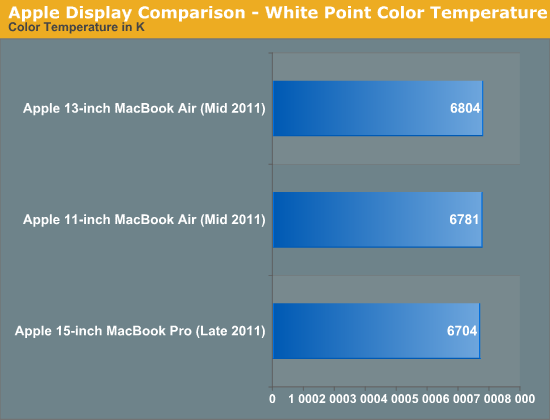
Apple wants to deliver as consistent of an experience as possible across its product line. While the Air models still don't have quite as high quality a panel as the Pro, at least there aren't any wide variations in what constitutes white on these panels.
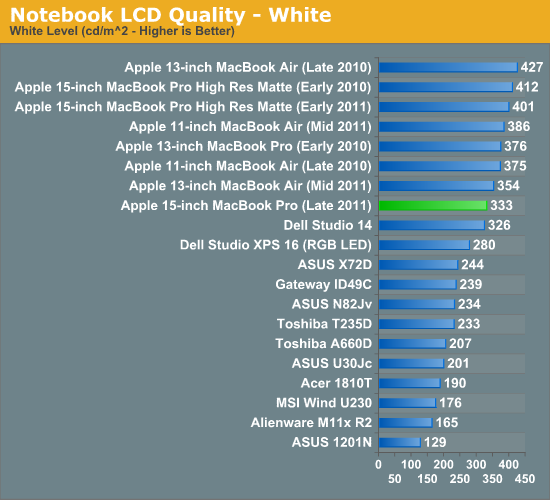
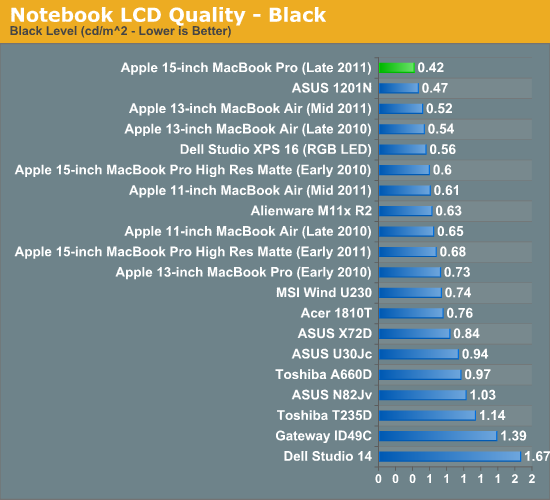
Brightness is down a bit compared to the high-res panel we looked at earlier this year, but so are black levels. The combination of the two actually results in a slightly higher contrast ratio than what we measured on the early 2011 models. In practice the panel looks just as good and seems to get just as blindingly bright as my personal 15-inch.
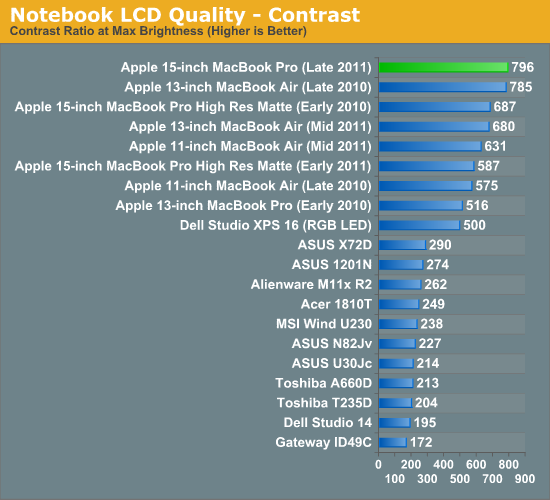
Color quality and gamut are virtually identical as well, no surprises here:
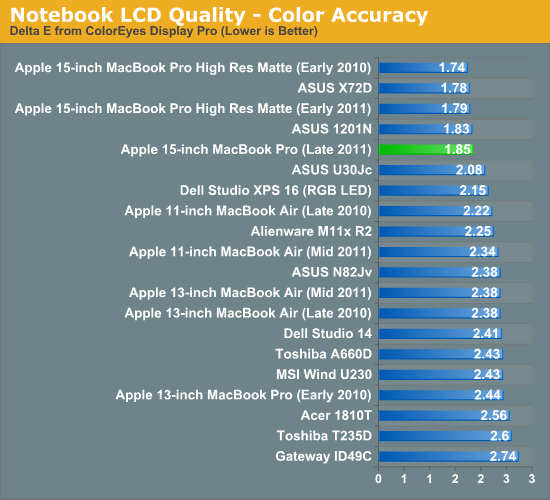

Hard Drive
The more traditional Macs (MBP, Mac Pro, iMac) continue to ship with mechanical hard drives by default, the late 2011 update is no different. My review sample came with a 5400RPM Toshiba MK5064GSXF. The drive features two 320GB platters (obviously not all in use for the 500GB capacity), and an 8MB cache.
All of my personal systems use SSDs and in testing the new MBP with a hard drive I can only say that the move back is more painful than ever. It's most noticeable when multitasking. Installing applications while browsing the web and copying files just seems to slow to a crawl compared to my SSD equipped MacBook Pro. If you're going to buy any new machine, especially if you're paying top dollar for something you expect to feel fast, you definitely need an SSD.

The good news is Apple's SSD pricing isn't horribly unreasonable, at least at the beginning. For $200 you can upgrade the 15-inch MacBook Pro to a 128GB drive (most likely a 3Gbps Samsung based SSD). It's when you look at the 256GB or larger drives that you're probably better off buying your own. You can buy a 256GB Crucial m4 for under $400 today, and a 240GB Vertex 3 will set you back around $460. Both options are cheaper (and faster) than Apple's $600 256GB upgrade. If you get the high-end 15-inch MBP model however, the upgrade prices drop by $100 - making the Apple route much more cost competitive. You don't get the same performance you would from an aftermarket drive, but with less headaches and potential for issues it's possibly a better route.
The 512GB drives are most definitely not a bargain from Apple. To equip a 15-inch MBP with a 512GB SSD, Apple wants $1200. You're much better off buying a 512GB Samsung SSD 830 for under $800 and pocketing the difference.
| Apple SSD Upgrade Pricing | |||||
| 128GB | 256GB | 512GB | |||
| 13-inch 2011 MacBook Pro | $200 | $600 | $1200 | ||
| 13-inch 2011 MacBook Pro (high end) | $100 | $500 | $1100 | ||
| 15-inch 2011 MacBook Pro | $200 | $600 | $1200 | ||
| 15-inch 2011 MacBook Pro (high end) | $100 | $500 | $1100 | ||
| 17-inch 2011 MacBook Pro | $100 | $500 | $1100 | ||
What aftermarket SSD should you buy? If you want to play it safe and hang on to TRIM support, go with Apple. Ever since I've been reviewed SSDs however I've run aftermarket SSDs in my Macs, mostly without any major issues. I can vouch for the Intel SSD 510, Samsung SSD 830 and OCZ Vertex 3. At one point or another I've used all of them in my 2011 MacBook Pro. My current setup is a Samsung 830 in the primary drive bay and an Intel SSD 510 in place of my optical drive, the combination works wonderfully.
Still Great WiFi
Apple continues to quietly focus on delivering excellent WiFi performance with the MacBook Pro. In the late 2011 models WiFi is still powered by Broadcom's BCM4331 3x3 solution. A quick test with a 3rd generation Time Capsule showed us peak transfer rates of 154Mbps, in line with what we've seen with the first generation Sandy Bridge MacBook Pro.

Despite Apple's move to Bluetooth 4.0 support on some of its other platforms, the MacBook Pro remains at 2.1 with the same BCM2070 controller.
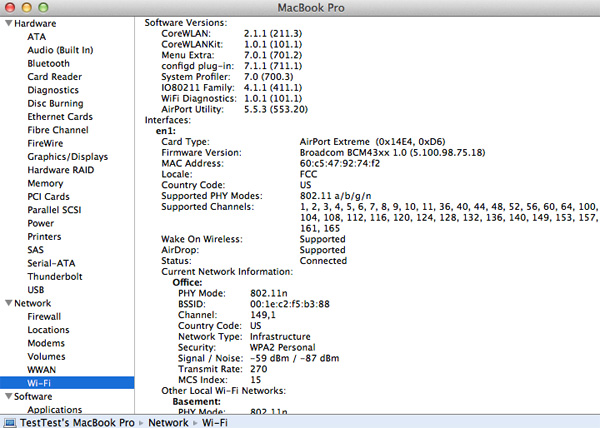


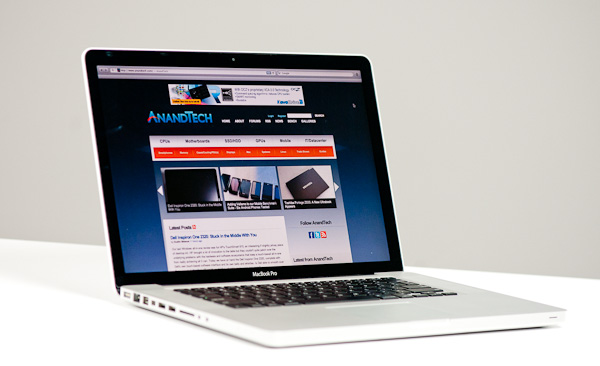








101 Comments
View All Comments
KoolAidMan1 - Friday, November 18, 2011 - link
"there are plenty of laptops that are designed to do real work for people that has real jobs"LOL
JarredWalton - Friday, November 18, 2011 - link
No one has Jobs any more. RIP. ;-)Corland - Tuesday, November 22, 2011 - link
Too soon Jarred.;-)
robco - Friday, November 18, 2011 - link
Your G73 is a 17" laptop and weighs over a kilo more (3.85 vs 2.54). Of course it's going to be faster. Many users are quite happy to have a thinner, lighter machine. If you care more about raw performance then the MBP is not for you. There's more to performance than fps numbers in games. Gaming has never been OS X's strong suit. For your needs, a Windows laptop is a much better choice.Personally, I wouldn't want to lug the ASUS around, but that's just me.
GotThumbs - Monday, November 21, 2011 - link
I think the key thing to keep in mind, is that you CAN obtain (minus TB Port) an equally impressive PC based laptop for significantly less cash. With the $aving$ of purchasing a PC over a MBP, you can then upgrade to 8Gigs of ram (for less than Apple charges) and load a decent SSD as well.The real question most general consumers ask themselves is.... Do you want to be seen with an Apple product or not, and how much am I willing to pay for that fashion accessory?
I'd be willing to bet that most MBP users (Include PC users as well) are not using even 50% of the systems capabilities. FB, Tweater, email, ITUNES do not utilize/need much processing power. In a society where woman can easily spend thousands on a purse, Apple has become somewhat of an accessory for women and men. I'm not saying ALL MPB users are motivated by fashion, but we all know a majority of users probably are. Just ask them about the specs and why thy chose an Apple laptop.
It's an individual choice of how one spends their hard earned money. Personally I choose to avoid Apples controlling environment and do not own a single Apple product.
Best Wishes,
Mystermask - Monday, November 28, 2011 - link
"Just ask them about the specs"Because specs tell so much about usability, productivity, TCO and value?
Personally I choose to avoid arrogant, narrow minded people.
CharonPDX - Thursday, November 17, 2011 - link
The Early 2011 model is the upgraded model, the Late 2011 model is the entry-level. So basically you're getting 99% of the prior "Upgraded" for the same price as the prior "Entry".gradjoh - Thursday, November 17, 2011 - link
Okay, thanks, that makes sense.zhill - Thursday, November 17, 2011 - link
The model he is reviewing is the "low end" 15" MBP, the other in the charts is the 2.3GHz upgraded "high end" MBP, so they aren't exactly apples-to-apples. Basically, the previous high end is still faster than the new low-end. It's a somewhat confusing comparison since he doesn't have numbers for the "low end" 2.0Ghz config of "early 2011". For the same $1799 you get a faster machine now, but the $2199 config from the last iteration is still faster.sigmatau - Friday, November 18, 2011 - link
Why would they use a $100 GPU in a $2500 laptop? Wow, now that is a ripoff.